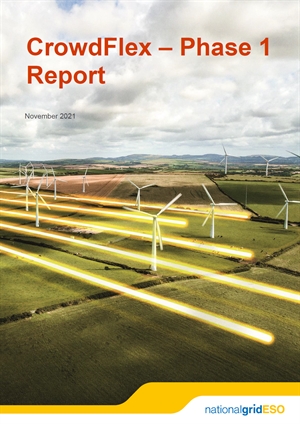Study shows that increasing domestic flexibility could reduce peak electricity demand by 23%
Sun 16 January 2022
View all news

The largest study into the potential for domestic energy customers to flexibly manage their electricity use has shown that peak demand could be reduced by nearly a quarter in active households and that those with an EV (electric vehicle) provided the greatest flexibility. The Crowdflex study was sponsored by National Grid ESO, SSEN Distribution and involved the participation of Octopus Energy and Ohme.
The study investigated how 25,000 households responded to price signals by reducing or increasing electricity demand. Its findings could have major implications for how the grid is run in future.
Flexibility is the ability to shift the timing and location of both the consumption and generation of electricity. It is expected to play a crucial role in a cost-effective transition to net zero and a smart system which uses technologies to balance supply and demand and manage constraints on the network.
The expected widespread introduction of electric vehicles as well as other technical innovations (such as the introduction of domestic smart meters) has been a prompt for greater focus on the potential for domestic demand-side management. The Zemo Partnership-convened EV Energy Taskforce has placed significant emphasis on the prospects in this area and the CrowdFlex report's industrial participants are key players in the Taskforce's community.
With electricity demand predicted to approximately double, primarily as a result of the introduction of EVs and electric heating, according to National Grid ESO’s Future Energy Scenarios, reliable measures that manage demand and help balance the grid will be crucial in delivering a net zero future cost effectively.
Using Octopus and Ohme’s large customer datasets and analysis products, Crowdflex analysed the impact of two types of signalling to customers:
Enduring signals, created by customers who chose to move from a flat tariff to a time-of-use (ToU) tariff
- One-off signals, which asked customers to sign up to a “Big Turn Up” or “Big Turn Down” event and rewarded those who changed their demand over a specified two-hour period
- Customers on ToU tariffs significantly reduced their demand during the evening peak by 15-17% and maintained that reduction over six months. Households that owned an electric vehicle (EV) showed a greater ability to flex their demand, achieving reductions of up to 23% in the proportion of a household’s daily demand consumed during the evening peak.
Responses to one-off signals were similarly significant and strongly affected by EV ownership, the study found. The “Big Turn Up” saw an increase in the magnitude of average electricity demand expected during a household’s evening peak by 617% for EV owning households, or 131% in non-EV owning households. The “Big Turn Down” request saw very significant reduction in demand compared to the average evening peak power demand; -59% in demand over the period for EV households and -41% for non-EV households.
The findings from Crowdflex are encouraging because the very high level of participation by EV drivers suggests a willingness in those households to provide EV assets for flexibility.
Related Links
< Back to news list